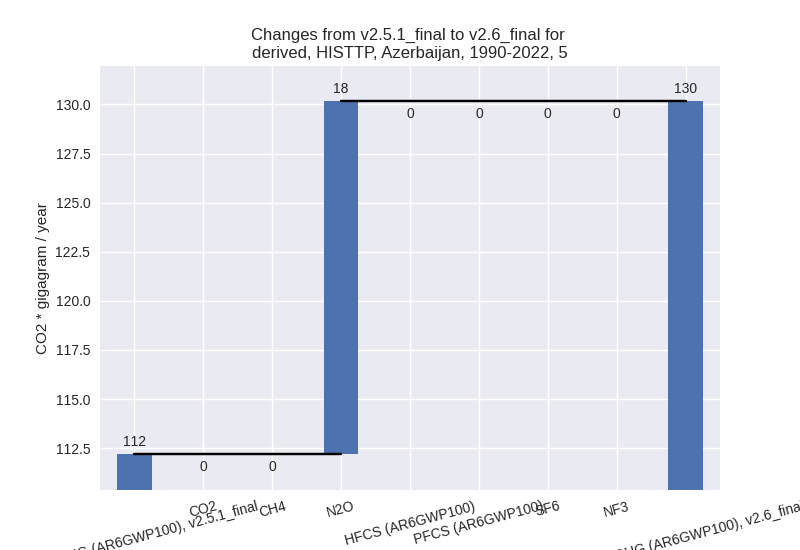Changes in PRIMAP-hist v2.6_final compared to v2.5.1_final for Azerbaijan
2024-09-24
Johannes Gütschow
Change analysis for Azerbaijan for PRIMAP-hist v2.6_final compared to v2.5.1_final
Overview over emissions by sector and gas
The following figures show the aggregate national total emissions excluding LULUCF AR6GWP100 for the country reported priority scenario. The dotted linesshow the v2.5.1_final data.
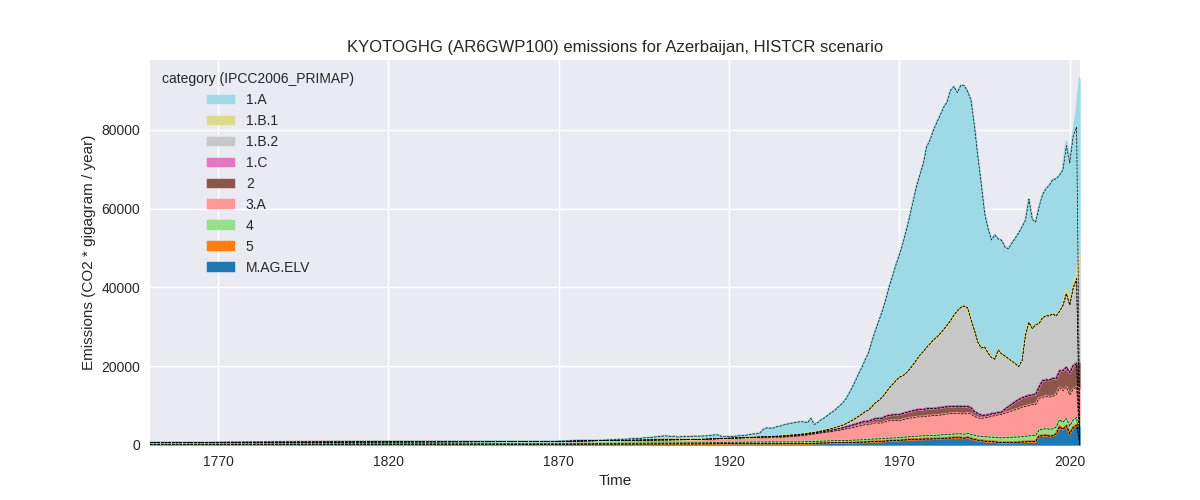

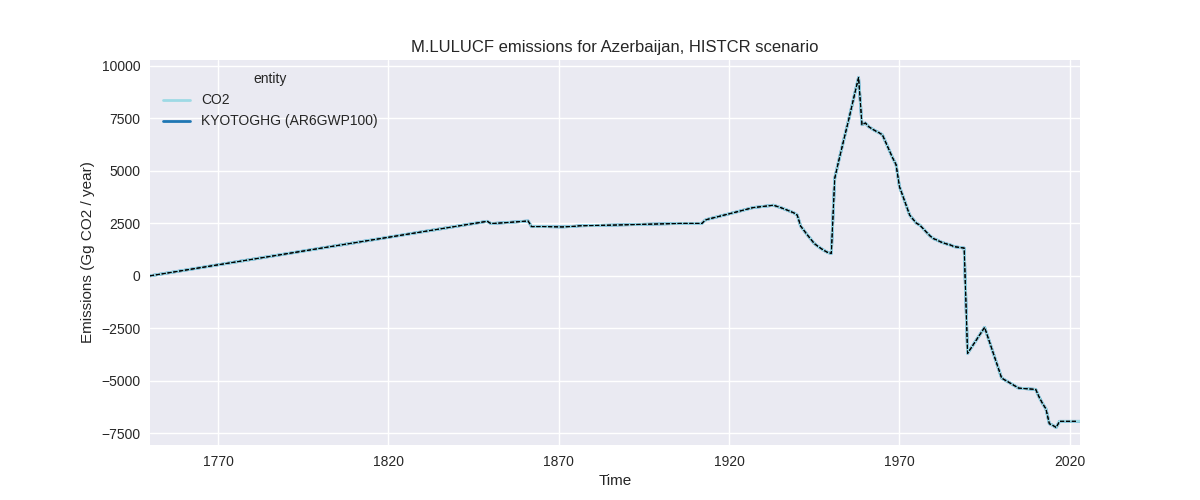
The following figures show the aggregate national total emissions excluding LULUCF AR6GWP100 for the third party priority scenario. The dotted linesshow the v2.5.1_final data.
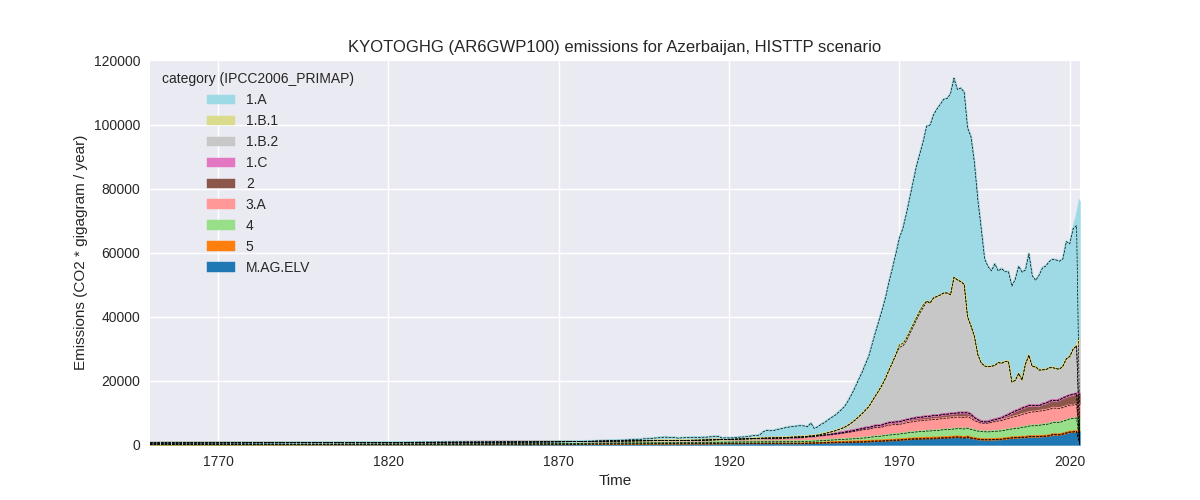
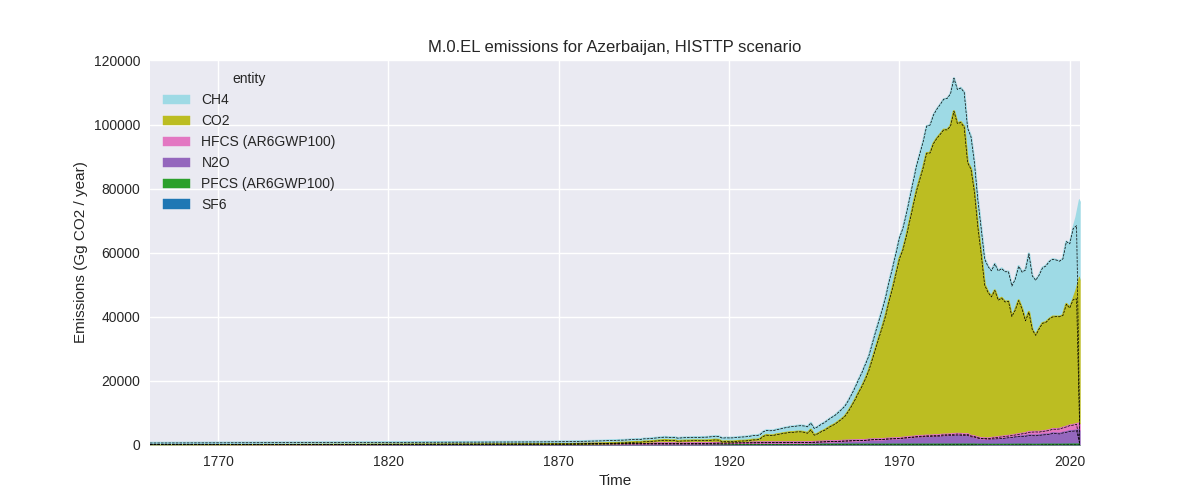
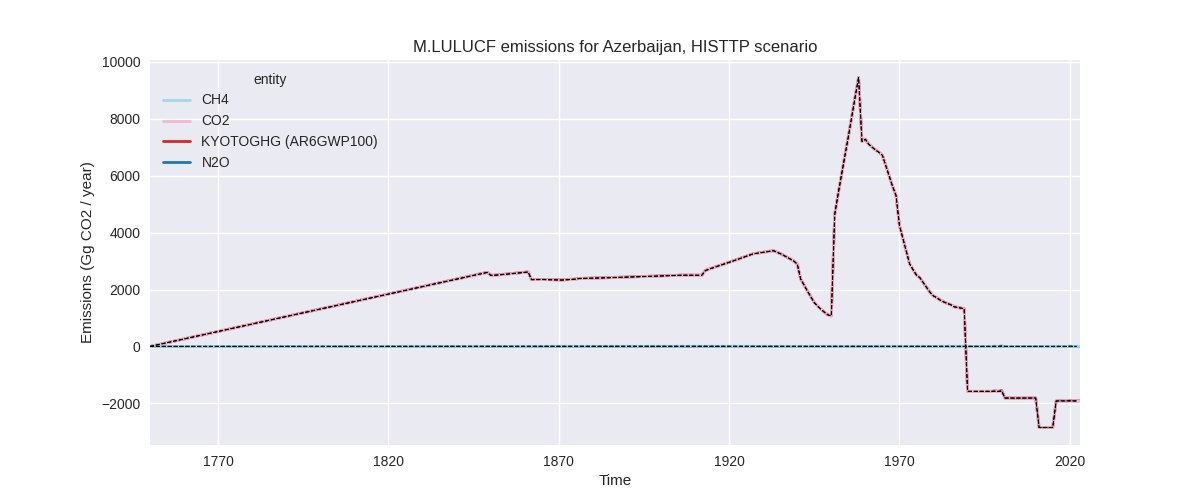
Overview over changes
In the country reported priority scenario we have the following changes for aggregate Kyoto GHG and national total emissions excluding LULUCF (M.0.EL):
- Emissions in 2022 have changed by 4.8%% (3845.55 Gg CO2 / year)
- Emissions in 1990-2022 have changed by 0.3%% (188.77 Gg CO2 / year)
In the third party priority scenario we have the following changes for aggregate Kyoto GHG and national total emissions excluding LULUCF (M.0.EL):
- Emissions in 2022 have changed by 3.8%% (2593.23 Gg CO2 / year)
- Emissions in 1990-2022 have changed by 0.2%% (97.54 Gg CO2 / year)
Most important changes per scenario and time frame
In the country reported priority scenario the following sector-gas combinations have the highest absolute impact on national total KyotoGHG (AR6GWP100) emissions in 2022 (top 5):
- 1: 1.A, CO2 with 2664.93 Gg CO2 / year (7.0%)
- 2: 1.B.2, CO2 with 925.64 Gg CO2 / year (22.4%)
- 3: 2, PFCS (AR6GWP100) with 263.91 Gg CO2 / year (29.3%)
- 4: 4, CH4 with -61.13 Gg CO2 / year (-3.1%)
- 5: 2, HFCS (AR6GWP100) with 30.63 Gg CO2 / year (1.2%)
In the country reported priority scenario the following sector-gas combinations have the highest absolute impact on national total KyotoGHG (AR6GWP100) emissions in 1990-2022 (top 5):
- 1: 1.B.2, CO2 with 108.75 Gg CO2 / year (3.4%)
- 2: 1.A, CO2 with 75.16 Gg CO2 / year (0.2%)
- 3: 2, PFCS (AR6GWP100) with 8.00 Gg CO2 / year (2.1%)
- 4: 4, CH4 with -6.80 Gg CO2 / year (-0.5%)
- 5: 2, CH4 with 2.74 Gg CO2 / year (34.4%)
In the third party priority scenario the following sector-gas combinations have the highest absolute impact on national total KyotoGHG (AR6GWP100) emissions in 2022 (top 5):
- 1: 1.A, CO2 with 2591.33 Gg CO2 / year (7.0%)
- 2: 4, CH4 with -100.99 Gg CO2 / year (-2.5%)
- 3: 1.B.2, CO2 with 46.89 Gg CO2 / year (11.7%)
- 4: 5, N2O with 25.83 Gg CO2 / year (23.6%)
- 5: 2, PFCS (AR6GWP100) with 21.51 Gg CO2 / year (32.4%)
In the third party priority scenario the following sector-gas combinations have the highest absolute impact on national total KyotoGHG (AR6GWP100) emissions in 1990-2022 (top 5):
- 1: 1.A, CO2 with 73.08 Gg CO2 / year (0.2%)
- 2: 5, N2O with 17.97 Gg CO2 / year (16.0%)
- 3: 1.B.1, CO2 with 17.37 Gg CO2 / year (inf%)
- 4: 4, CH4 with -10.96 Gg CO2 / year (-0.4%)
- 5: 1.B.2, CO2 with -1.38 Gg CO2 / year (-0.0%)
Notes on data changes
Here we list notes explaining important emissions changes for the country. ’' means that the following text only applies to the TP time series, while means that it only applies to the CR scenario. Otherwise the note applies to both scenarios.
- 2022 change in energy CO2 due to updated EI data (CR and TP)
- Changes in sectors 4 and 5 are due to the removal of FAOSTAT data.
- 2022 changes in other sectors are due to the shorter extrapolation trend period (CR, TP).
Changes by sector and gas
For each scenario and time frame the changes are displayed for all individual sectors and all individual gases. In the sector plot we use aggregate Kyoto GHGs in AR6GWP100. In the gas plot we usenational total emissions without LULUCF. ## country reported scenario
2022
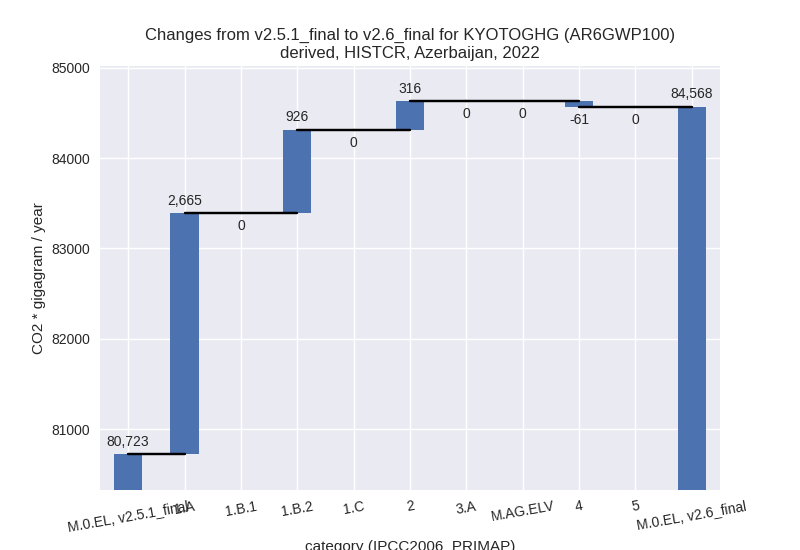

1990-2022
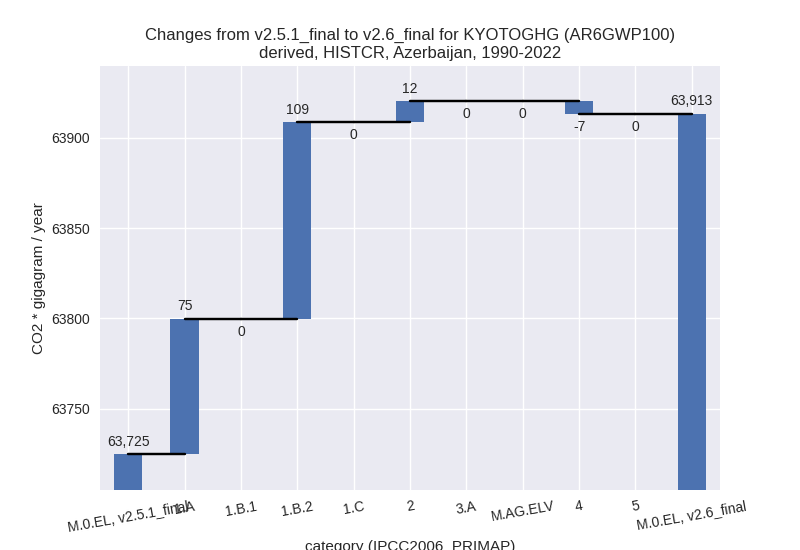
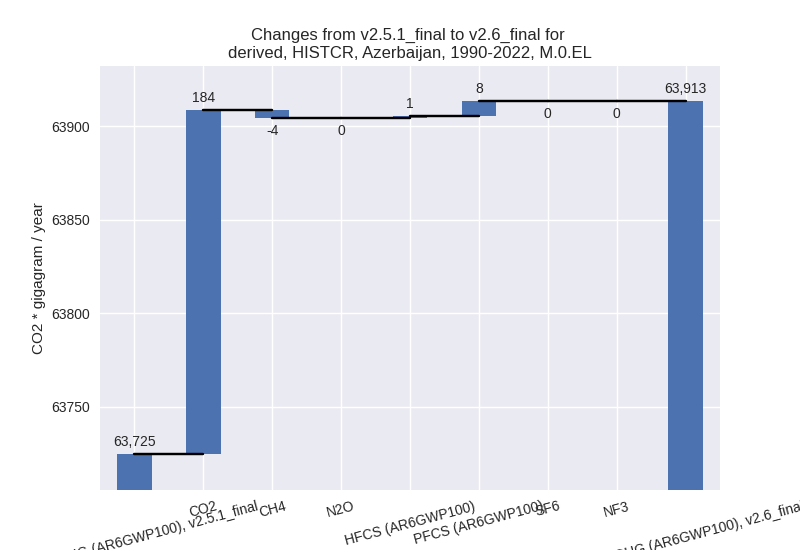
third party scenario
2022
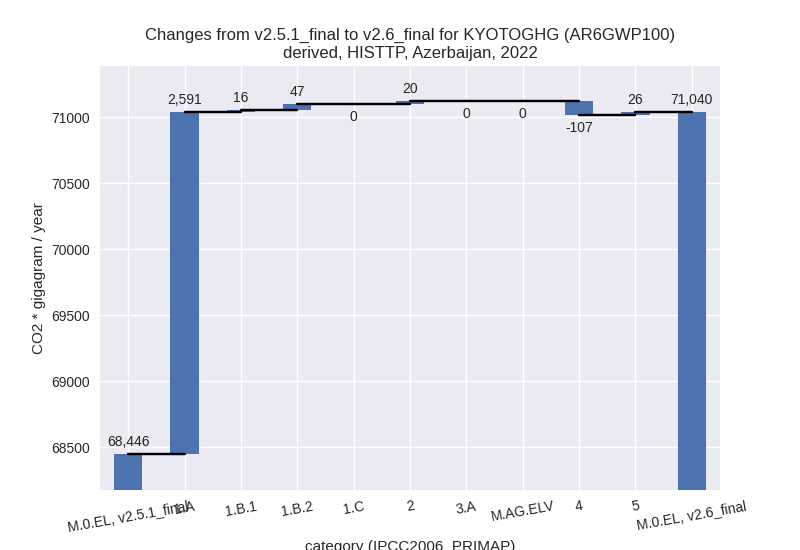
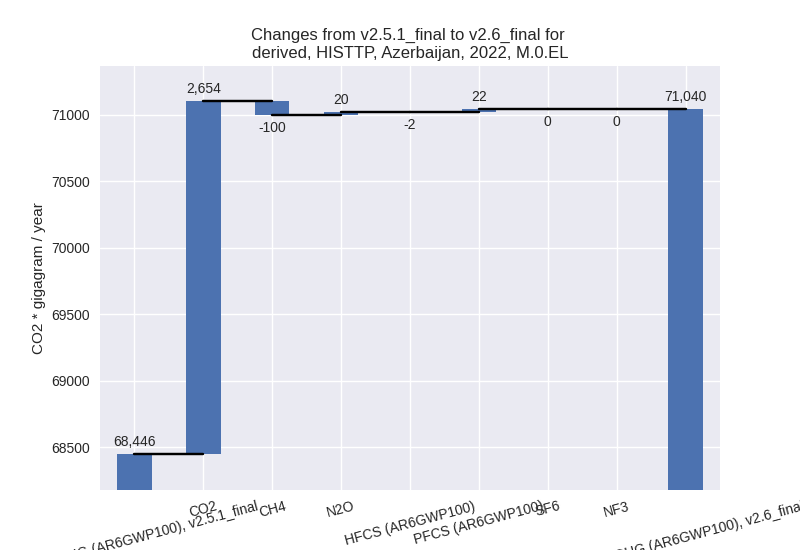
1990-2022
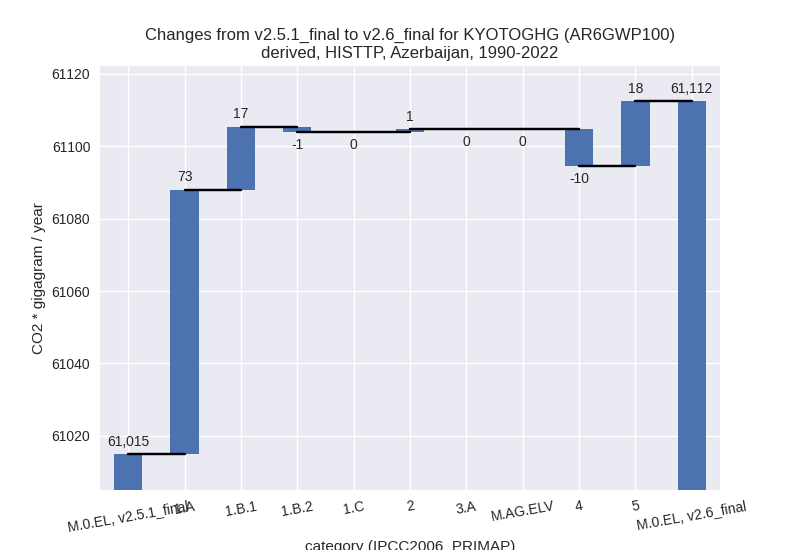
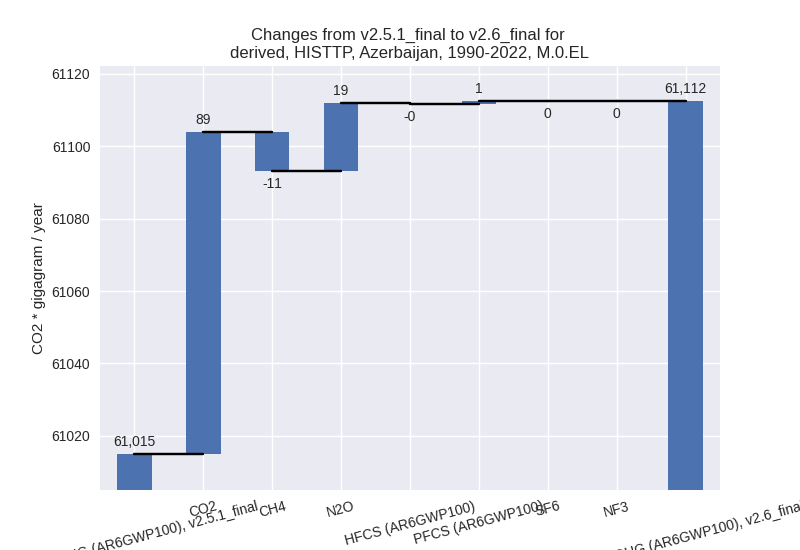
Detailed changes for the scenarios:
country reported scenario (HISTCR):
Most important changes per time frame
For 2022 the following sector-gas combinations have the highest absolute impact on national total KyotoGHG (AR6GWP100) emissions in 2022 (top 5):
- 1: 1.A, CO2 with 2664.93 Gg CO2 / year (7.0%)
- 2: 1.B.2, CO2 with 925.64 Gg CO2 / year (22.4%)
- 3: 2, PFCS (AR6GWP100) with 263.91 Gg CO2 / year (29.3%)
- 4: 4, CH4 with -61.13 Gg CO2 / year (-3.1%)
- 5: 2, HFCS (AR6GWP100) with 30.63 Gg CO2 / year (1.2%)
For 1990-2022 the following sector-gas combinations have the highest absolute impact on national total KyotoGHG (AR6GWP100) emissions in 1990-2022 (top 5):
- 1: 1.B.2, CO2 with 108.75 Gg CO2 / year (3.4%)
- 2: 1.A, CO2 with 75.16 Gg CO2 / year (0.2%)
- 3: 2, PFCS (AR6GWP100) with 8.00 Gg CO2 / year (2.1%)
- 4: 4, CH4 with -6.80 Gg CO2 / year (-0.5%)
- 5: 2, CH4 with 2.74 Gg CO2 / year (34.4%)
Changes in the main sectors for aggregate KyotoGHG (AR6GWP100) are
- 1: Total sectoral emissions in 2022 are 63653.06 Gg
CO2 / year which is 75.3% of M.0.EL emissions. 2022 Emissions have
changed by 6.0% (3590.56 Gg CO2 /
year). 1990-2022 Emissions have changed by 0.4% (183.91 Gg CO2 / year). For 2022 the
changes per gas
are:
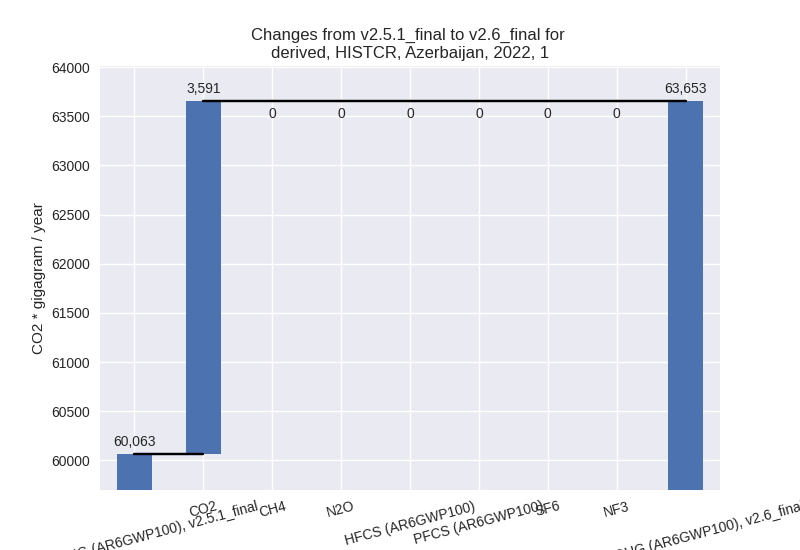
The changes come from the following subsectors:- 1.A: Total sectoral emissions in 2022 are 41170.51
Gg CO2 / year which is 64.7% of category 1 emissions. 2022 Emissions
have changed by 6.9% (2664.93 Gg CO2
/ year). 1990-2022 Emissions have changed by 0.2% (75.16 Gg CO2 / year). For 2022 the
changes per gas
are:
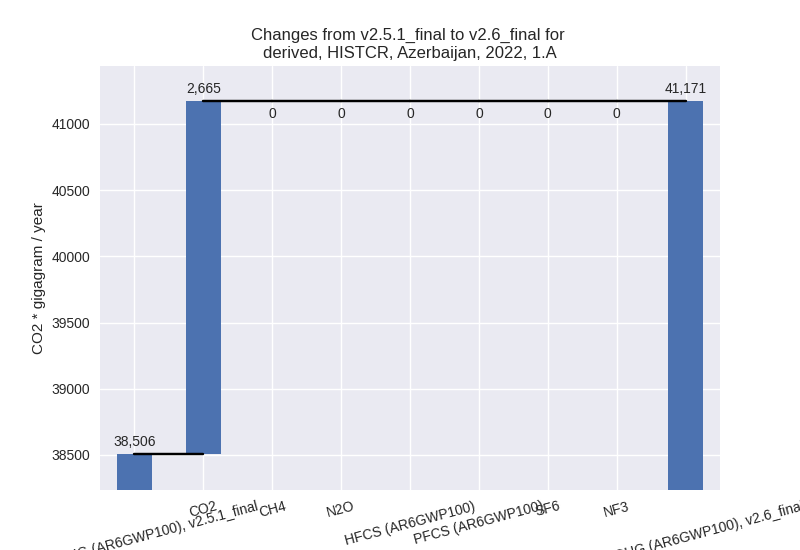
There is no subsector information available in PRIMAP-hist. - 1.B.2: Total sectoral emissions in 2022 are
22482.55 Gg CO2 / year which is 35.3% of category 1 emissions. 2022
Emissions have changed by 4.3%
(925.64 Gg CO2 / year). 1990-2022 Emissions have changed by 0.7% (108.75 Gg CO2 / year). For 2022 the
changes per gas
are:
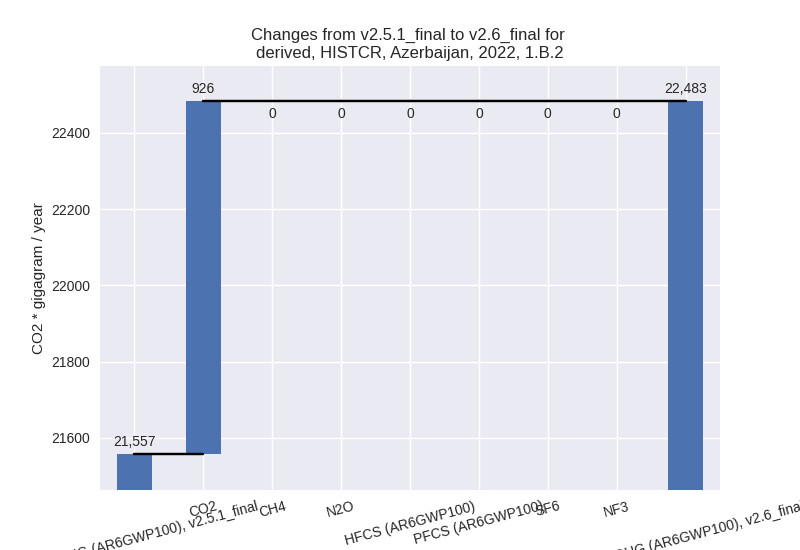
There is no subsector information available in PRIMAP-hist.
- 1.A: Total sectoral emissions in 2022 are 41170.51
Gg CO2 / year which is 64.7% of category 1 emissions. 2022 Emissions
have changed by 6.9% (2664.93 Gg CO2
/ year). 1990-2022 Emissions have changed by 0.2% (75.16 Gg CO2 / year). For 2022 the
changes per gas
are:
- 2: Total sectoral emissions in 2022 are 6243.27 Gg
CO2 / year which is 7.4% of M.0.EL emissions. 2022 Emissions have
changed by 5.3% (316.11 Gg CO2 /
year). 1990-2022 Emissions have changed by 0.4% (11.67 Gg CO2 / year). For 2022 the
changes per gas
are:
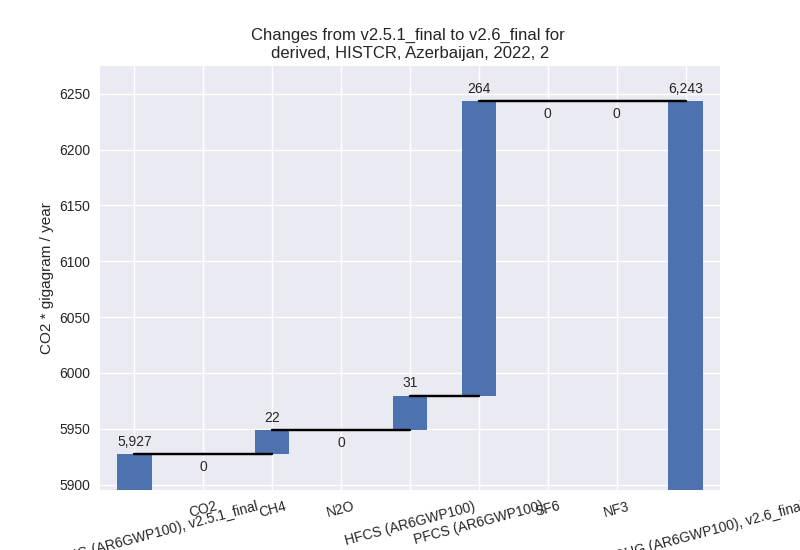
- M.AG: Total sectoral emissions in 2022 are 12791.40 Gg CO2 / year which is 15.1% of M.0.EL emissions. 2022 Emissions have changed by 0.0% (0.00 Gg CO2 / year). 1990-2022 Emissions have changed by 0.0% (0.00 Gg CO2 / year).
- 4: Total sectoral emissions in 2022 are 1880.38 Gg
CO2 / year which is 2.2% of M.0.EL emissions. 2022 Emissions have
changed by -3.1% (-61.13 Gg CO2 /
year). 1990-2022 Emissions have changed by -0.5% (-6.80 Gg CO2 / year). For 2022 the
changes per gas
are:
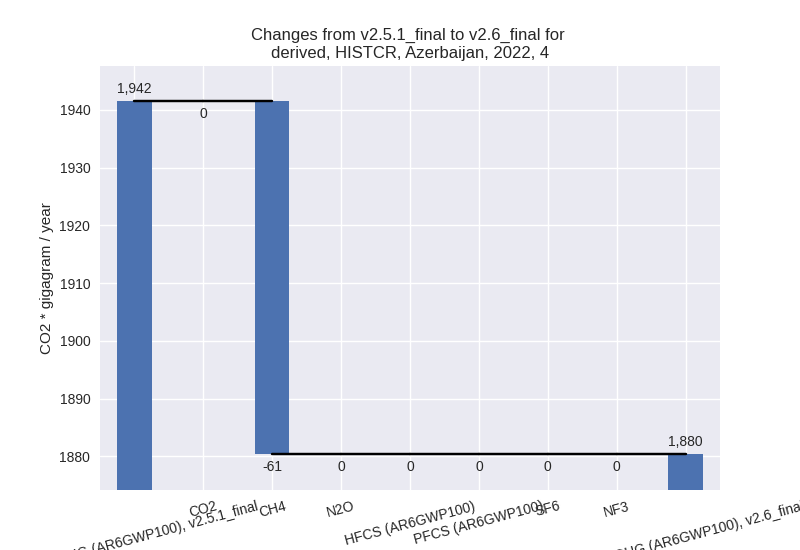
- 5: No data
third party scenario (HISTTP):
Most important changes per time frame
For 2022 the following sector-gas combinations have the highest absolute impact on national total KyotoGHG (AR6GWP100) emissions in 2022 (top 5):
- 1: 1.A, CO2 with 2591.33 Gg CO2 / year (7.0%)
- 2: 4, CH4 with -100.99 Gg CO2 / year (-2.5%)
- 3: 1.B.2, CO2 with 46.89 Gg CO2 / year (11.7%)
- 4: 5, N2O with 25.83 Gg CO2 / year (23.6%)
- 5: 2, PFCS (AR6GWP100) with 21.51 Gg CO2 / year (32.4%)
For 1990-2022 the following sector-gas combinations have the highest absolute impact on national total KyotoGHG (AR6GWP100) emissions in 1990-2022 (top 5):
- 1: 1.A, CO2 with 73.08 Gg CO2 / year (0.2%)
- 2: 5, N2O with 17.97 Gg CO2 / year (16.0%)
- 3: 1.B.1, CO2 with 17.37 Gg CO2 / year (inf%)
- 4: 4, CH4 with -10.96 Gg CO2 / year (-0.4%)
- 5: 1.B.2, CO2 with -1.38 Gg CO2 / year (-0.0%)
Changes in the main sectors for aggregate KyotoGHG (AR6GWP100) are
- 1: Total sectoral emissions in 2022 are 55065.49 Gg
CO2 / year which is 77.5% of M.0.EL emissions. 2022 Emissions have
changed by 5.1% (2654.18 Gg CO2 /
year). 1990-2022 Emissions have changed by 0.2% (89.08 Gg CO2 / year). For 2022 the
changes per gas
are:
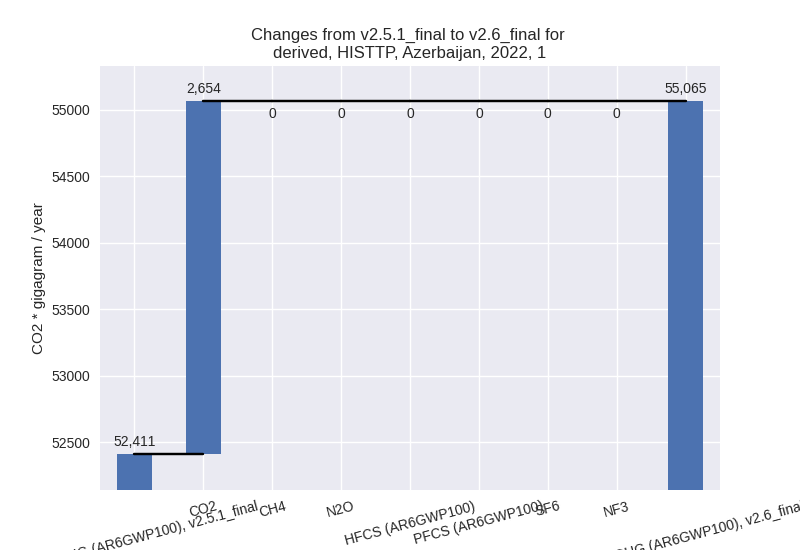
The changes come from the following subsectors:- 1.A: Total sectoral emissions in 2022 are 40090.71
Gg CO2 / year which is 72.8% of category 1 emissions. 2022 Emissions
have changed by 6.9% (2591.33 Gg CO2
/ year). 1990-2022 Emissions have changed by 0.2% (73.08 Gg CO2 / year). For 2022 the
changes per gas
are:
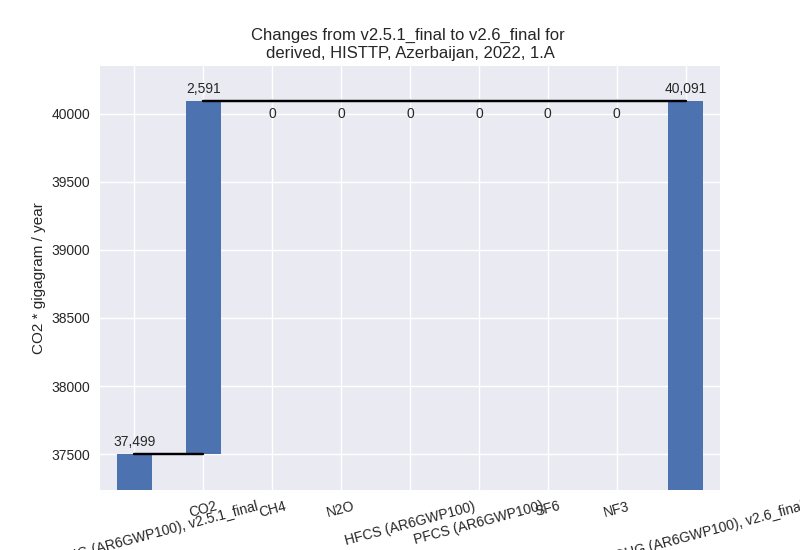
There is no subsector information available in PRIMAP-hist. - 1.B.1: Total sectoral emissions in 2022 are 16.15
Gg CO2 / year which is 0.0% of category 1 emissions. 2022 Emissions have
changed by 8329.5% (15.95 Gg CO2 /
year). 1990-2022 Emissions have changed by 197.8% (17.37 Gg CO2 / year). For 2022 the
changes per gas
are:
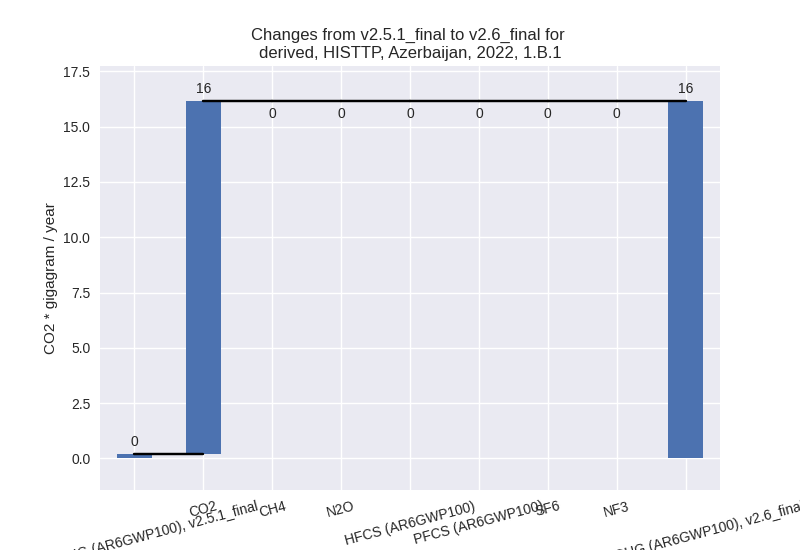
For 1990-2022 the changes per gas are: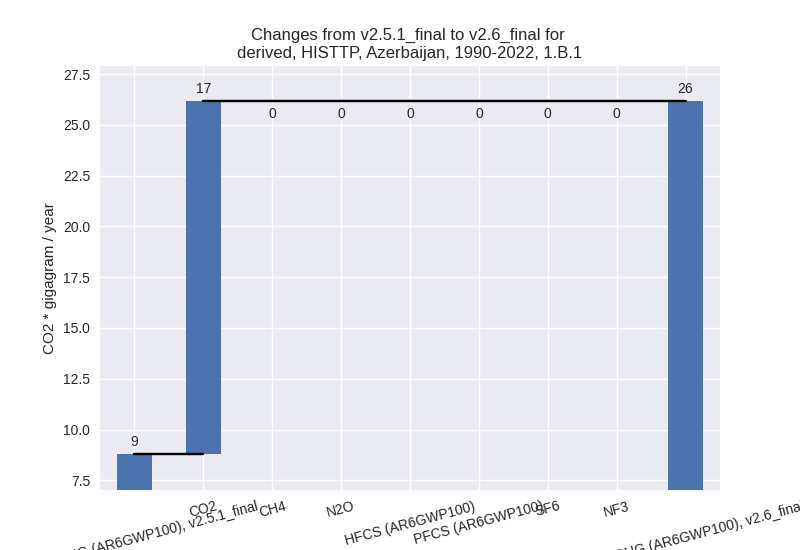
There is no subsector information available in PRIMAP-hist. - 1.B.2: Total sectoral emissions in 2022 are 14958.63 Gg CO2 / year which is 27.2% of category 1 emissions. 2022 Emissions have changed by 0.3% (46.89 Gg CO2 / year). 1990-2022 Emissions have changed by -0.0% (-1.38 Gg CO2 / year).
- 1.A: Total sectoral emissions in 2022 are 40090.71
Gg CO2 / year which is 72.8% of category 1 emissions. 2022 Emissions
have changed by 6.9% (2591.33 Gg CO2
/ year). 1990-2022 Emissions have changed by 0.2% (73.08 Gg CO2 / year). For 2022 the
changes per gas
are:
- 2: Total sectoral emissions in 2022 are 3398.89 Gg CO2 / year which is 4.8% of M.0.EL emissions. 2022 Emissions have changed by 0.6% (20.35 Gg CO2 / year). 1990-2022 Emissions have changed by 0.0% (0.67 Gg CO2 / year).
- M.AG: Total sectoral emissions in 2022 are 8374.99 Gg CO2 / year which is 11.8% of M.0.EL emissions. 2022 Emissions have changed by 0.0% (0.00 Gg CO2 / year). 1990-2022 Emissions have changed by 0.0% (0.00 Gg CO2 / year).
- 4: Total sectoral emissions in 2022 are 4064.91 Gg
CO2 / year which is 5.7% of M.0.EL emissions. 2022 Emissions have
changed by -2.6% (-107.12 Gg CO2 /
year). 1990-2022 Emissions have changed by -0.3% (-10.18 Gg CO2 / year). For 2022 the
changes per gas
are:
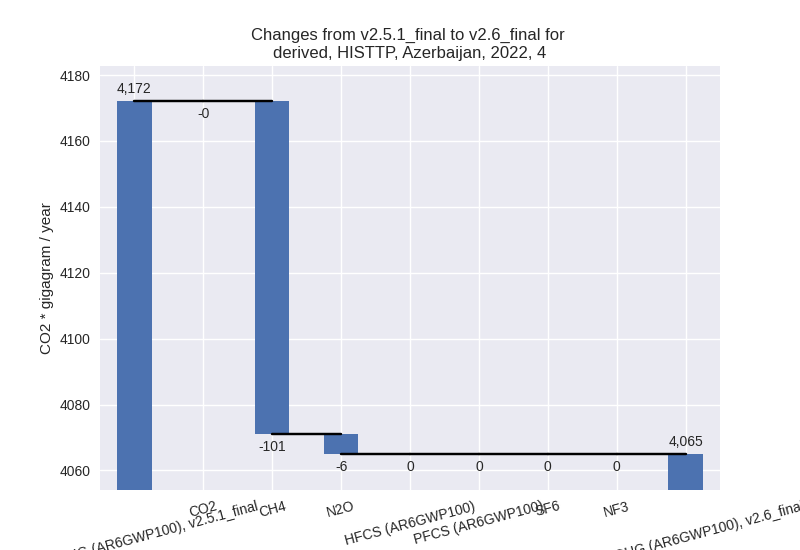
- 5: Total sectoral emissions in 2022 are 135.37 Gg
CO2 / year which is 0.2% of M.0.EL emissions. 2022 Emissions have
changed by 23.6% (25.83 Gg CO2 /
year). 1990-2022 Emissions have changed by 16.0% (17.97 Gg CO2 / year). For 2022 the
changes per gas
are:
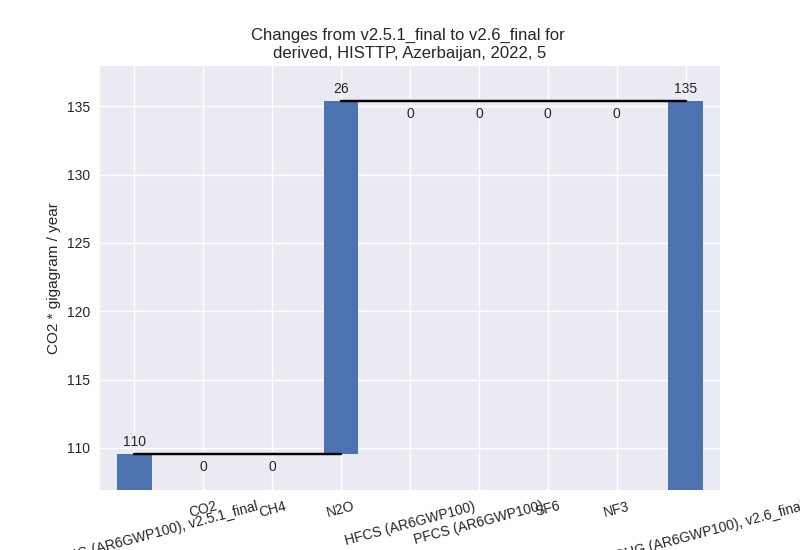
For 1990-2022 the changes per gas are: